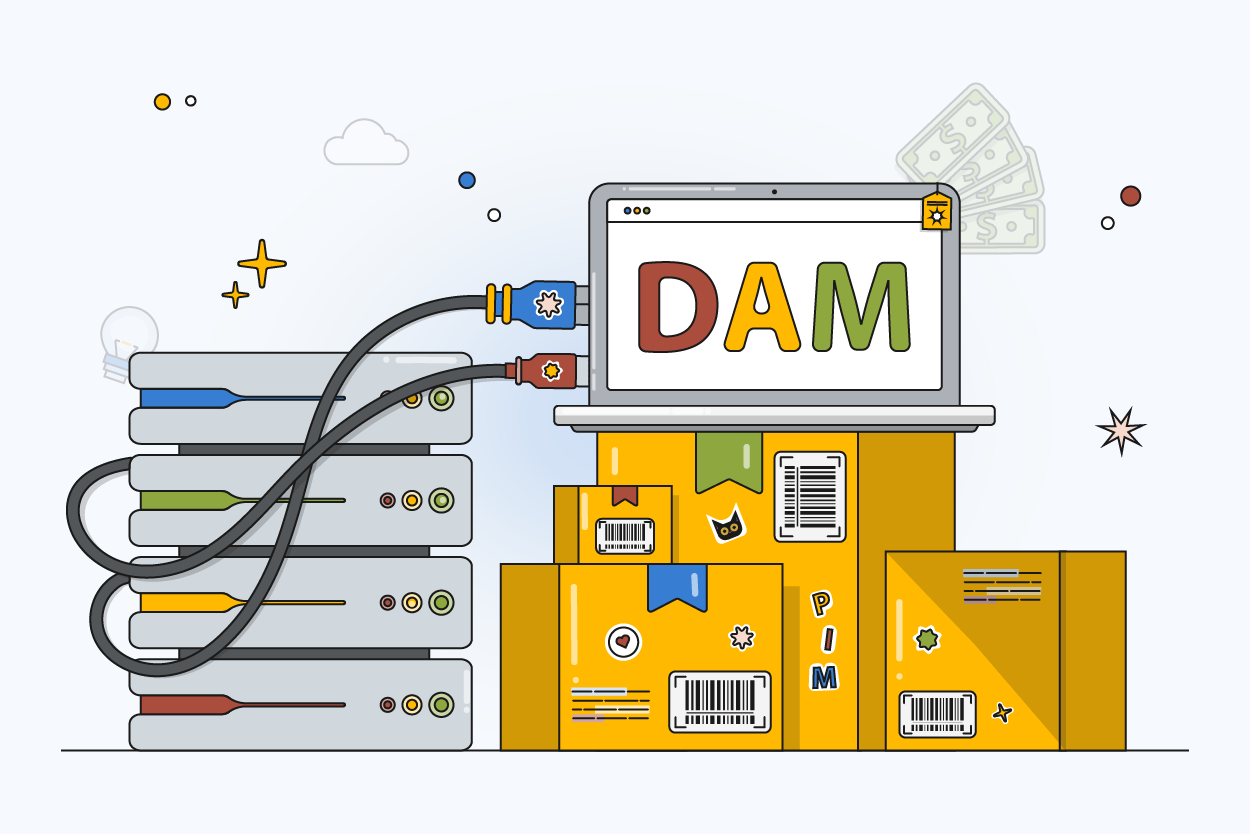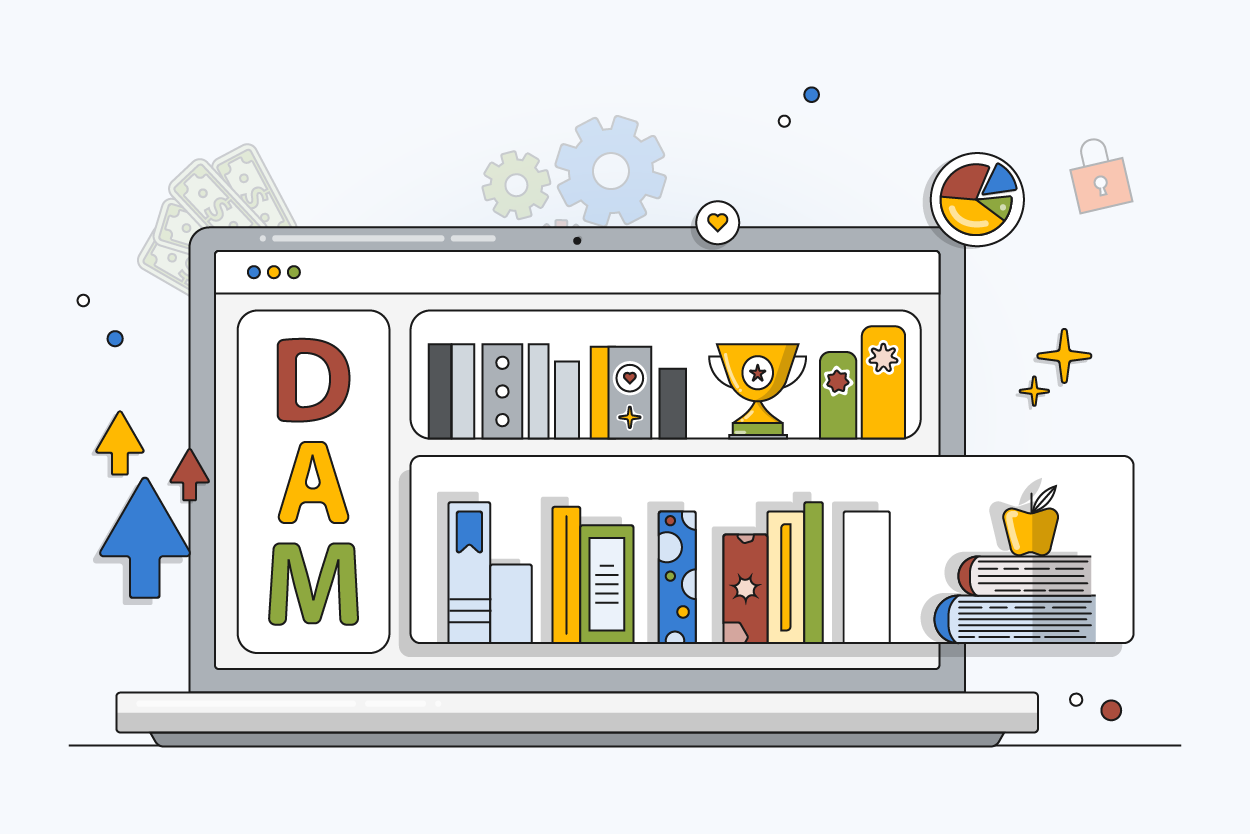Blog » Top 10 Benefits of Digital Assets Management (DAM) For Ecommerce Businesses
Top 10 Benefits of Digital Assets Management (DAM) For Ecommerce Businesses
Author name: Bradley Taylor
Digital Asset Management (DAM) systems have become vital tools for organizations looking to maximize the value of their digital content. A DAM can offer a wide array of benefits not found with other solutions. In this post, we’ll explore the key advantages of DAM and how it can transform the way you work with digital assets.
What is Digital Assets Management (DAM)?
Digital Asset Management (DAM) is the process of organizing, storing, and distributing digital files. A DAM system is the tool that facilitates this process. Specifically, a DAM system acts as a central repository for digital assets. From there, teams can edit and distribute the digital content as required. Common file types supported by a DAM include:
- Images (JPEG, PNG, GIF, etc.)
- Videos (MP4, MOV, AVI, etc.)
- Audio (MP3, WAV, etc.)
- Documents (PDF, Microsoft Word, etc.)
- Design and Layout Files (Adobe Photoshop, Figma, etc.)
- 3D and CAD Files (AutoCAD, STL, etc.)
Why Do You Need a DAM System?
A DAM system is essential for organizations with a large volume or diverse types of digital content. Modern companies rely on digital content to connect with audiences and to support their operations. Without a way to efficiently manage this content, organizations can suffer from disorganization, lost files, and inconsistent branding. DAM addresses this problem, allowing companies to make the most of their digital assets.

10 Benefits of a Digital Assets Management System
From better organization and workflows to improved branding and cost savings, DAM offers a diverse range of benefits. Let’s examine the top 10 benefits of a DAM system and how using it can impact your business.
1. Better Asset Organization and Accessibility
A DAM system provides a centralized location for storing and categorizing digital assets. This lets users locate needed files without wasting time on extensive searches. With a DAM, teams can configure metadata tags, filter by asset type and details, or use the built-in search functionality to access data assets more efficiently. As a result, the entire organization can leverage this enhanced accessibility to improve overall productivity.
For example, with a DAM platform built with a product information management (PIM) solution, a manufacturing company with an extensive catalog can use the platform to store all datasheets, images, technical specifications, and any other product information related to each item. By doing so, the sales and distribution teams will always have access to complete and accurate information. With the best information in hand, the teams can ensure product information is consistent across marketing materials, catalogs, and distribution channels.
2. Manage Assets In A Single Centralized System
Today’s businesses must handle a large volume of data assets. From marketing creatives to product images and descriptions, many resources are needed to thrive in the digital ecosystem. DAM technology centralizes these assets into a single source of truth. This centralization eliminates the need for multiple storage solutions. It also prevents files from being scattered across disparate drives and folders.
With a single, unified system, teams can avoid duplicative work and the headaches resulting from confusion over the correct file version. One of the most impactful advantages of a digital asset management tool is that minimizes miscommunication about content usage. It does so through its strong categorization features which allow for clear access to current and approved assets. This structure is even more important for remote or cross-functional teams that need reliable file access to collaborate effectively.
3. Streamlined Multichannel Distribution
Modern companies must reach customers at multiple touchpoints to remain competitive. Research shows that 72% of consumers prefer to connect with brands across multiple marketing channels. DAM systems can help simplify multichannel distribution. They do so by making it easy for marketing teams to locate and share the assets best optimized for each platform’s unique requirements.
With just a few clicks, DAM systems provide access to platform-specific versions of product images, videos, or any other type of data asset. As a result, marketing and product teams can access the appropriate assets for different channels without spending time resizing or reformatting assets for each channel.
Additionally, A DAM system’s robust capabilities make it ideal for distributing video and other multimedia file types across various platforms. For example, consider a digital media company or streaming service that manages an extensive library of audio and video content. With a DAM, the company has a central repository that can manage licensing and usage rights, and also distribute assets across multiple platforms.
4. Better Brand Consistency
Maintaining a cohesive and consistent brand image across channels is crucial to establishing trust with your audience. A DAM system allows you to conveniently organize brand-approved assets. By doing so, you can ensure that each channel only receives images, designs, and descriptions that follow brand guidelines. This consistency reinforces the brand’s identity. As a result, more customers will recognize the brand, no matter the channel.
DAM systems support version control to ensure everyone within the organization has access to the most up-to-date brand assets. This can prevent team members from using outdated material in campaigns and promotions. By eliminating these inconsistencies, the brand can create a seamless experience that maximizes brand integrity and customer loyalty.
5. Saves Time and Money
Managing thousands of digital assets is often a costly endeavor. This effect is amplified when assets are disorganized or difficult to locate. Implementing a DAM system may come with an upfront investment. But, in the long run, the DAM capabilities can lead to significant cost savings for your business. By providing a centralized asset management system, a DAM reduces the total cost required to store and manage your data.
A DAM system can also save your organization a considerable amount of time. With a DAM, there is no need to waste hours searching through scattered folders or cloud drives to locate files. Instead, all assets are housed in a single, organized repository. This drastically reduces the time spent on manual searches, allowing for increased productivity and more time to focus on higher-value tasks.

6. Analytics and Data-Driven Insights
DAM systems include analytics that provide insights into asset usage. This can include downloads, usage patterns, user engagement, and channel performance. These insights are a stark difference from most other software solutions which don’t provide specific analytics on digital assets. For example, an eCommerce platform typically gives you product conversion rate, sales metrics, and page visits, but it doesn’t provide specific insights into how many people engage with a particular product image.
Understanding digital asset performance can provide unique and valuable insights. These insights can help improve decision-making by showing you which assets perform the best and how assets perform on different channels. With this information, you can determine high-performing content to ensure you focus resources on what is most impactful.
7. Personalization and Segmentation
Personalized experiences are essential to customer loyalty. Across industries, consumers expect modern companies to provide a buying experience that matches their unique interests. According to Invesp, 45% of online shoppers are more likely to shop with businesses offering personalized product recommendations.
A DAM system enables highly targeted personalization by allowing teams to segment and customize assets for specific audiences. This precise targeting makes it easy to deliver tailored experiences at scale.
8. Streamlines Your Workflow
A DAM system streamlines workflow efficiency. It does so by centralizing asset management and automating key processes. Teams can easily locate and collaborate on assets while reducing manual searches and file transfers. This eliminates the bottlenecks and miscommunications that can seriously impair the speed of your projects.
Additionally, DAM systems help simplify the review and approval process. DAM features like automated approvals help organizations speed up campaign rollouts as teams don’t need to redundantly approve every asset change. This can be particularly beneficial for eCommerce companies that manage regular product launches and seasonal promotion campaigns.
9. Integration With Third-Party Apps
DAM systems offer robust third-party integration. This includes the ability to seamlessly connect with eCommerce platforms, social media management tools, and email marketing software, among others. These integrations enable asset accessibility and ensure smooth communication between systems. They also remove the need for manual uploads and transfers across platforms
A strong integration system is vital to distributing digital assets efficiently. A DAM ensures that digital assets are always available for every piece of your tech stack. For example, product images stored in your DAM can be instantly available for posts from your social media management tool, or to create a new product listing on a third-party marketplace.
10. Improved Collaboration and Teamwork
A DAM system fosters improved collaboration for teams of all sorts. Beyond streamlining operations through a centralized repository, DAM platforms often include built-in commenting and approval features. These features enable feedback and finalizations to occur directly within the system, making it easier for cross-functional teams to work together with the same assets. Plus, with permission-based roles, team members can work together without worrying about unauthorized edits or version control issues.
Choosing the DAM Solution That Will Most Benefit Your Team
Selecting the right DAM solution is an important strategy decision and crucial to getting the most benefits of asset management software. To find the right tool for your organization you should start by analyzing solutions for core asset management features. This includes robust categorization capabilities, version control, user permissions, and seamless integrations.
From there, you’ll want to consider your specific needs. Factors such as the size of your asset library, the number of users who will access the system, and the types of media you will manage will all play a role in what solution is right for your business.

How To Start Enjoying the Benefits of DAM
Digital asset management is crucial in today’s fast-paced digital environment. With the right DAM solution, your team can streamline workflows, and improve asset efficiency while enjoying the many other benefits of a DAM system.
Modified on: 11/05/2024
